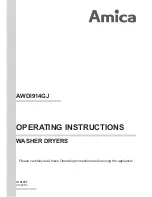
Technical Information
239
G 1xxx/G 2xxx
17
Dishwasher Detergents and Phosphates
Dishwasher detergents no longer contain phosphates
In March 2006, Washington State became the first state in the nation to ban
phosphates from dishwasher detergents. By 2010, 15 other states adopted
this policy and enacted similar bans. Faced with this growing dilemma, the
major dishwasher detergent manufacturers agreed to stop producing
phosphate-laden detergents by July 2010. The quantity of the active
ingredient, STPP, sodium tripolyphosphate, was reduced from nearly 35% by
weight down to 0.5% by weight.
Why use phosphates?
As a detergent additive, STPP is really the key ingredient. Phosphates help
remove food and grease, keep insoluble dirt in suspension, maintain proper
pH, reduce the risk of corrosion, and keep food and other particles from
depositing on surfaces inside the dishwasher. Along with doing the lion’s
share of the work, STPP is also a cost-effective additive in detergents.
Why ban phosphates?
Phosphorus is one of many elements essential to life. When phosphorus gets
into fresh water, it acts like a fertilizer for algae. When the bumper crop of
algae later dies, its decomposition consumes oxygen in the water. Reduced
levels of dissolved oxygen in water are harmful to fish. Excess levels of
phosphorus can lead to widespread fish kills. In reality, the majority of
phosphorus pollution can be attributed to heavy industry, mining operations,
fertilizer and animal waste runoff from agriculture, and to a much lesser
extent, effluent from sewage treatment plants containing trace amounts from
– you guessed it – dishwasher detergents.
Dishwashing problems without phosphates
After the removal of phosphates from all major brands of dishwasher
detergents in July 2010, it took about 6 months for existing store stocks to sell
out. It’s no wonder that, starting in 2011, consumer complaints grew at an
alarming rate. Some of these complaints are:
Dishes no longer shine
Gritty film left on glasses and plates
Silverware turning black
Food particles remaining on silverware and dishes
White film & deposits on dishwasher surfaces
Destruction of non-stick surfaces
What to do?
These problems are being experienced by dishwasher owners all over the
country. All brands and all models are affected. Our MieleCare brand
detergents, also phosphate-free, have been the cause of relatively few
complaints, so they can be recommended as a possible solution. Other
detergent manufacturers are looking for new, environmentally friendly
additives, but until they find one, there is no easy answer. See the following
links to learn more:
Summary of Contents for ADVANTA G 2170
Page 1: ...TECHNICAL INFORMATION G 1xxx and G 2xxx Dishwashers All US Models 2012 Miele USA ...
Page 43: ...Technical Information 43 G 1xxx G 2xxx 010 Casing ...
Page 47: ...Technical Information 47 G 1xxx G 2xxx Figure 010 5 Side Hinge Retaining Screw ...
Page 48: ...Technical Information 48 G 1xxx G 2xxx 020 Door ...
Page 64: ...Technical Information 64 G 1xxx G 2xxx 030 Front Panel ...
Page 68: ...Technical Information 68 G 1xxx G 2xxx 040 Inner Cabinet ...
Page 77: ...Technical Information 77 G 1xxx G 2xxx 050 Water Paths ...
Page 220: ...Technical Information 220 G 1xxx G 2xxx 100 Fascia Panel Touchtronic Navitronic Incognito ...
Page 226: ...Technical Information 226 G 1xxx G 2xxx 130 Cutlery Tray ...


































